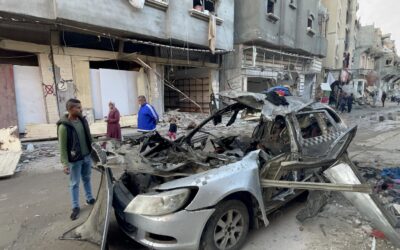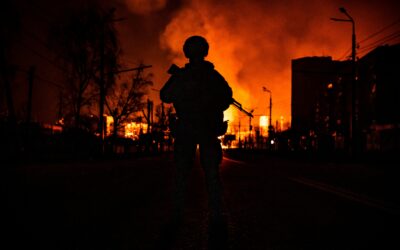
In Future Wars, Drone Weapons With Minds of Their Own
SUBSCRIBER+EXCLUSIVE BRIEFING — Drone weapons are part of the daily narrative of the war in Ukraine – from Russia’s use of Iranian drones against infrastructure […] More
Bottom Line Up Front
The United States government and a wide range of human rights and interest groups closely monitor Iran’s human rights record. Since 2011, the United Nations has assigned a ‘special rapporteur’ to examine Iran’s human rights practices, although this oversight has been blunted by Tehran’s refusal to allow the U.N. rapporteur into Iran. Iran’s human rights record is heavily scrutinized internationally in part because the United States and, to a lesser extent, U.S. allies in Europe, consider Iran a significant threat to their interests in the region. Highlighting Iran’s human rights abuses provides the United States and its allies additional leverage against the leadership in Iran, even though no government, including that of the United States, has made Iranian human rights improvements a specific condition in any potential security, political, or economic agreements.
Since the inception of the Islamic Republic in 1979, Iran’s human rights record has been widely assessed as atrocious. The regime has been repeatedly cited for frequent use of executions, including of minors, continued stonings to death in some locations, vigorous enforcement of a strict dress code for women, the use of torture, and discrimination against ethnic and religious minorities, particularly the Baha’is. Most of these elements of Iran’s human rights record have been consistently abysmal throughout the 40 years of the regime. The regime’s record has worsened most notably in the form of aggressive efforts to suppress political and economic dissent. In two recent episodes of serious unrest – in late 2017- early 2018 and in mid-November 2019 – the regime quickly deployed security forces, including the Islamic Revolutionary Guard Corps (IRGC) and the Basij volunteer militia force the IRGC controls, to forcibly counter demonstrators, particularly against those the security forces deemed to have used violence. Those episodes of unrest involved over 100 cities and towns throughout the country. In the November unrest, Amnesty International reports that the regime killed over 300 protesters, many of whom were killed when security forces recaptured control of the town of Mahshahr that protesters had seized. In these rounds of unrest, the regime also shut down Internet access so that protesters could not organize, and undertook mass arrests of protesters after demonstrations had ceased. In an effort to appease public sentiment, Iranian leaders, including Supreme Leader Ali Khamene’i, acknowledged government mistakes and accepted citizens’ right to protest peacefully, insisting that security forces only acted against demonstrators who attacked security forces or property.
The Trump administration, and in particular Secretary of State Mike Pompeo, has been emphasizing Iran’s forceful tactics as part of its campaign to apply ‘maximum pressure’ on Iran’s economy and isolate it diplomatically. On December 19, 2019, Secretary Pompeo gave a speech at the Hoover Institution specifically titled ‘Human Rights and the Iranian Regime,’ outlining the elements of the regime’s abuses of protesters in the November 2019 unrest. He announced that the State Department had received 36,000 pieces of information from inside Iran, documenting regime abuses, in response to a solicitation for such reports. Administration officials have also said that the government killed 1,500 protesters in its attempt to suppress the November uprising – a figure several times higher than that cited by Amnesty International. The U.S. assertions, along with Pompeo’s statements, suggest that the Trump administration retains hope that its Iran policy will stoke unrest inside Iran to either destabilize the regime or compel it to capitulate to U.S. demands. The bulk of those demands nonetheless concern Iran’s regional influence and support for regional armed factions, and not improvement in Iran’s human rights record (beyond releasing the American and dual American-Iranian nationals held by Iran).
If the Trump administration’s strategy is to destabilize Iran or pressure it from within, there is no evidence that the strategy is succeeding. Major unrest flared in Iran in 2009-2010, at a time when there were virtually no significant U.S. secondary sanctions in effect on Iran and the Obama administration was seeking to engage Tehran diplomatically. There has been no sign in recent rounds of unrest of any divisions or defections within the Iranian security services. Unlike recent unrest in Lebanon and Iraq, there have been no major resignations among Iranian leaders or significant governmental changes. Nor has Iran softened any of its conditions to enter into negotiations with the Trump administration. All of which suggest that the administration’s Iran policy is having little effect on regime decision-making, composition, or stability.
Related Articles

SUBSCRIBER+EXCLUSIVE BRIEFING — Drone weapons are part of the daily narrative of the war in Ukraine – from Russia’s use of Iranian drones against infrastructure […] More

SUBSCRIBER+ EXCLUSIVE ANALYSIS — Iran’s retaliatory strikes against Israel this weekend were both a potentially game-changing, historic first — and an underwhelming response. Historic, because […] More

SUBSCRIBER+EXCLUSIVE INTERVIEW — Ukraine was hit by a fresh round of Russian missile attacks on Thursday, strikes that targeted and damaged the country’s power grid […] More

SUBSCRIBER+ EXCLUSIVE REPORTING — The Israeli drone strike that killed three adult sons (who Israel says were Hamas operatives) and four grandchildren of Hamas’s Qatar-based […] More

BOTTOM LINE UP FRONT – In the spring of 2022, Ukraine beat back a Russian assault on the nation’s capital and punished the invaders on […] More

SUBSCRIBER+EXCLUSIVE — The Ukraine war has reached a “pivotal moment,” a “critical stage,” an “inflection point“ – all phrases used to describe the current situation […] More
Search